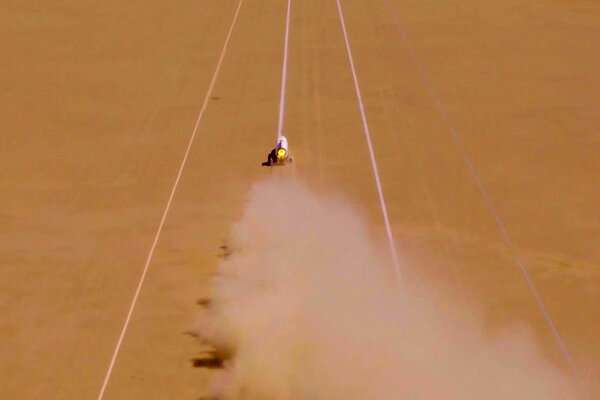November 4, 2019 weblog
Bloodhound's 461-mph speed is big but team eyes bigger record ahead

The Bloodhound, the darling of The Bloodhound LSR jet car project, has good reason to be praised as a speed rockstar, with speed now at 461mph (741km/h).
On Nov. 1 the Bloodhound smashed its own 450 mph target speed. And with the first run successfully completed, Bloodhound-had a speed of 461 mph (742 km/h) —the fastest the jet car has achieved yet.
So, is the team gets closer to breaking the current land speed record? Future testing will be watched closely and eagerly.
The 461-mph scene was southern Africa on Nov. 1. The car moved across a dried-out lakebed, said Jonathan Amos, BBC Science Correspondent, in the Kalahari desert. Amos: "The Bloodhound project is led from the UK but is being hosted by the Northern Cape government. Local people have cleared Hakskeen Pan of stones. The hope is this flat lakebed can become a draw for other racers in the future."
Amos said that, unofficially, this speed made the Bloodhound the third fastest British car of all time.
What makes it so unofficial? Amos explained it wasn't running under "proper" land speed record rules for the car to make two runs through a measured mile inside an hour. The recognized speed is then the average of the two passes. eTeknix: "Albeit, we should note that this wasn't a formally recorded speed as it was unable to make a 2nd run due to high winds."
First run successfully completed - 461mph
2nd run not started as cross winds gusting too high!
Heading back to base now #2019HST #BloodhoundLSR pic.twitter.com/e3HG7DcEWV
— Bloodhound LSR (@Bloodhound_LSR) November 1, 2019
A second run was planned but had to be aborted due to high winds and minor body damage, said CarBuzz. Minor body damage?
On Nov. 3 the team reported minor bodywork damage.
The team identified an issue with the titanium skin on the aerodynamic bodywork that covers the rear suspension.
"The issue was with an 'into wind step', which is an area of the bodywork that high speed air and desert grit blasted into as such a rate on this run, that it pealed back a corner, up to the first rivet. The Fabrication Team are trimming the 30mm long piece of titanium off before they bond and rivet a patch to cover the area."
The wonder vehicle is now doing what Amos said was "high-speed trials," as the vehicle's engineers work through tests "to verify the vehicle's design and the proper working of its subsystems." The run across the desert was to examine stability and brake chute performance, said Amos.
"Thrust SSC still holds the absolute land speed record of 763mph (1,228km/h) set in 1997," said Amos. "The driver on that occasion was RAF pilot Andy Green. The Wing Commander is at the controls again in Bloodhound."
Amos also reminded readers of a 403 mph (648km/h) speed by Donald Campbell in the Bluebird CN7 car in 1964. Bloodhound surpassed that.
CarBuzz: "These tests will provide crucial data to help Bloodhound prepare the car for its record attempt in 12-18 months when it will try to beat the current 763.035-mph land speed record set by Andy Green in 1997. If this is successful, the plan is to attempt to break the 1,000 mph barrier."
Speed watchers were impressed with the ambition and signs of progress with it all. Mike Sanders in eTeknix: "Admittedly, 461mph is quite a way off beating the current land speed record. In fact, it's almost exactly 300 miles per hour short! Given that this was the first test since the project hit a financial wall, this is, by far and away, the biggest achievement it has made to date."
One may compare the shape of the vehicle to an arrow or a pencil. The Bloodhound site said that the research and development process included "cutting-edge computational fluid dynamics (CFD) to determine the car's ideal shape."
What makes those behind the Bloodhound project so sure the vehicle can beat all the numbers in time? "Bloodhound has been built to smash the current land speed record of 763mph (1,228km/h) set by another British car, Thrust SSC, in 1997," said Amos.
The project web site asserted that "Advances in engineering design, materials and computational fluid dynamics (CFD)" since that last record just means "we can be confident of breaking that record with Bloodhound LSR."
That is what makes the British-made Bloodhound so interesting, said Digital Journal, namely, the vehicle's potential to break the supersonic record—and also the $80 million technology behind it.
Chest-thumping aside, the project team is pumped over what the efforts might contribute to the engineering community. "This project has inspired so many people over the last 10 years, including both students and the wider engineering community," said their project site. "Engineers like solving problems and theorising about what happens when you pass the limits of known understanding. We look forward to continuing this inspiration into the future."
More information: www.bloodhoundlsr.com/
© 2019 Science X Network




















